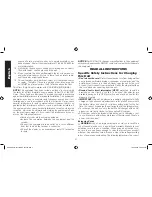
English
5
size to use depending on cord length and nameplate ampere rating.
If in doubt, use the next heavier gauge. The smaller the gauge number,
the heavier the cord.
MINIMUM GAGE FOR CORD SETS
Volts
Total Length of Cord in Feet
120V
0-25 26-50 51-100 101-150
(0-7.6m) (7.6-15.2m) (15.2-30.4m) (30.4-45.7m)
240V
0-50
51-100
101-200
201-300
(0-15.2m) (15.2-30.4m) (30.4-60.9m) (60.9-91.4m)
Ampere Rating
Extension Cord Length
More
Not more
0’-25’
26’-50’
51 ’-100 ’
101’ -150 ’
Than
Than
American Wire Gage (AWG)
0 -
6
18
16
16
14
6
-
10 18 16 14 12
10
-
12 16 16 14 12
12 -
16
14
12
Not Recommended
When an extension cord is used, make sure that:
•
the pins of extension cord are the same number, size and shape as
those in the charger,
•
the extension cord is properly wired and in good electrical condition,
and
•
the wire size is large enough for the AC rating of the charger.
WARNING:
NEVER ATTEMPT TO USE THE AC AND DC
CHARGING METHODS AT THE SAME TIME.
CAUTION
– To reduce the risk of injury or property damage:
Pull
the extension cord by the plug rather than the cord when disconnecting
from the built-in 120 volt AC charger or the AC outlet.
CAUTION
– To reduce the risk of injury or property damage when
charging using the 12 volt DC method:
•
Recharge using this method only when necessary. Frequent use of
the the 12 volt DC charging method may shorten battery life.
•
Do not exceed 6 hours charging time using this method.
Specific Safety Instructions for
Jump Starters
WARNING
– Burst hazard:
Do not use the unit for charging dry-cell
batteries that are commonly used with home appliances. These
batteries may burst and cause injury to persons and damage property.
Use the unit for charging/boosting a lead-acid battery only. It is not
intended to supply power to a low-voltage electrical system other than
in a starter-motor application.
WARNING
:
To reduce the risk of electric shock, never immerse this
unit in water or any other liquid, or use when wet.
WARNING
– Risk of explosive gases:
•
Working in the vicinity of a lead acid battery is dangerous. Batteries
generate explosive gases during normal battery operation. For this
reason, it is of the utmost importance that each time before using
the jump-starter you read this manual and follow instructions exactly.
•
To reduce the risk of battery explosion, follow these instructions and
those published by the battery manufacturer and manufacturer of
any equipment you intend to use in the vicinity of the battery. Review
cautionary markings on these products and on the engine.
WARNING
– To reduce the risk of fire:
•
Do not operate near flammable materials, fumes, dust or gases.
•
Do not expose to extreme heat or flames.
CAUTION
– To reduce the risk of injury or property damage:
•
NEVER ATTEMPT TO JUMP-START OR CHARGE A FROZEN
BATTERY.
•
Vehicles that have on-board computerized systems may be damaged
if vehicle battery is jump-started. Before jump-starting, read the
vehicle’s owner’s manual to confirm that external-starting assistance
is suitable.
•
When working with lead acid batteries, always make sure immediate
assistance is available in case of accident or emergency.
DXAEPS2_ManualENSP_101216.indd 5
10/19/2016 3:56:32 PM






































